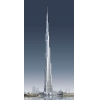|
 The craving for building something outstanding - the biggest, the longest, or
the widest - is so inherently human, though some would say «childish». Since
biblical times people have been trying to build the tallest building in the
world, and this idea has dominated minds and hearts of many generations. Maybe
it has something to do with a desire to get closer to stars and clouds, or it
is just the age long vanity, the desire to compete with the God. One way or
another, but the time has come when even the most daring fantasies may become
part of everyday life. The craving for building something outstanding - the biggest, the longest, or
the widest - is so inherently human, though some would say «childish». Since
biblical times people have been trying to build the tallest building in the
world, and this idea has dominated minds and hearts of many generations. Maybe
it has something to do with a desire to get closer to stars and clouds, or it
is just the age long vanity, the desire to compete with the God. One way or
another, but the time has come when even the most daring fantasies may become
part of everyday life.
Burj Dubai is a live picture of one of such dreams about the very highest
structure coming true. The fact, that there have already been some projects
nurtured exceeding «Dubai tower» (plain and simple when translated from Arabic)
in height, doesn't change anything. And it does not matter that another
skyscraper, Al-Burj (means «tower»), is being built some thirty miles (fifty
km) away from Burj Dubai site, which is meant to be even higher than Burj Dubai
- of prodigious 3,600 feet (1200 m). It is just unimportant: for some time Burj
Dubai is going to be the highest building in the world and this is what counts.
Well, it has already become the highest structure in the world even though the
building is far from being completed. In September 2008 Burj Dubai left behind
the previous record holder - a Chinese skyscraper in Taipei, with its 508
meters - 585 meters is not a joke. The total height of Burj Dubai has remained
a commercial secret from the very beginning of the construction in 2004, and up
to this day the exact figure has not been released. Different sources claim
different numbers - from 700 to 940 meters. The number of floors varies too, though
less - between 160 and 170 floors.
It happens quite often that man-made structures are inspired by Nature. In this
case it was a flower with an exotic name «hymenocallis». Its image, shape and
engineering solution (can we say «engineering solution» in regard to a flower?)
became a starting point of Burj Dubai design. To embrace the idea, one should
use a helicopter for a sight tour because not every bird flies that high, or to
get underground and take a look at the 110,000 ton foundation reaching 150 feet
(50 m) under the land surface. An American architect Adrian Smith has designed
the skyscraper, and the construction subdivision of South Korean Samsung is
implementing the fantasy in glass and concrete.
If you already nurture plans to build your own modest skyscraper of 1,500 or
1,800 feet high (500-600 m), we can give you some financial details here.
Preliminary estimates report $4,1 billion to complete Burj Dubai. And creators
of this new coming wonder of the world suggest that the skyscraper will be
truly priceless to the city of Dubai, not just a building, but sort of a city
unit within the city. In other words, the city of Dubai will get a new stand
alone district of Burj Dubai.
The first 37 floors will accommodate hotel rooms, and we have no doubt that
staying there will be rather expensive. There is no doubt, that apartments on
higher floors (from 45 to 108) will be even more expensive. The rest of the
building (up to 160 or 170 floors at constructors' will) will accommodate
numerous business offices, which can be acquired or rented. There will be no
offices only on the 123rd and the 124th floors; instead, there will be a lobby
and an observation site.
Burj Dubai is special not only for its height and astronomic costs but for
unique technologies used in its construction and maintenance. To begin with,
the building will, in fact, become an autonomous power station, independent of
external energy supply. Who needs energy supply when it is located in one of
the hottest places on Earth? Wind and solar power will serve it well with an
enormous 60-meter turbine processing energy of wind into electricity, and
15,000 square meters of solar panels.
Next, Burj Dubai sits in the climate zone with temperatures far from Siberian.
Therefore, cooling of the building becomes an issue. In order to cut AC costs
and to reduce clutter with additional wires and technical support systems, the
sunlight reflection system is installed. And a modern highly efficient AC
system will maintain 64 degrees F (18 degrees C). Will it be a nice escape from
the 120-degree F (50-degree C) or not?
It will take some time and patience to wait until these remarkable, though
fantastic, plans become real.
|